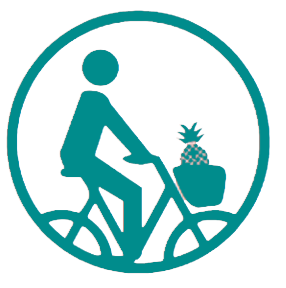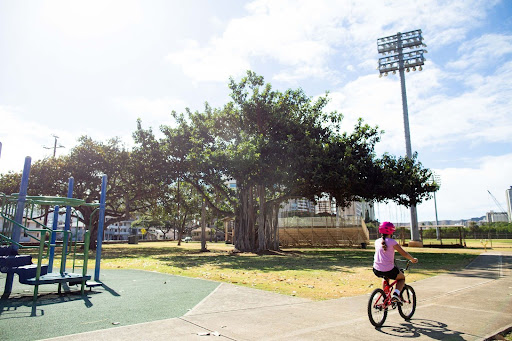Search for Indicators
 The Hawaiʻi Physical Activity and Nutrition (PAN) Plan 2030 is a guide to increasing physical activity and healthy eating in the state, with the long-term goal of reducing overweight, obesity, and chronic disease among all Hawaiʻi residents. Physical activity and healthy eating are vital in creating resilient communities and preventing many chronic diseases.
The Hawaiʻi Physical Activity and Nutrition (PAN) Plan 2030 is a guide to increasing physical activity and healthy eating in the state, with the long-term goal of reducing overweight, obesity, and chronic disease among all Hawaiʻi residents. Physical activity and healthy eating are vital in creating resilient communities and preventing many chronic diseases.
Physical Activity and Nutrition Plan 2030 Tracker
 The Hawaiʻi Physical Activity and Nutrition (PAN) Plan 2030 is a guide to increasing physical activity and healthy eating in the state, with the long-term goal of reducing overweight, obesity, and chronic disease among all Hawaiʻi residents. Physical activity and healthy eating are vital in creating resilient communities and preventing many chronic diseases.
The Hawaiʻi Physical Activity and Nutrition (PAN) Plan 2030 is a guide to increasing physical activity and healthy eating in the state, with the long-term goal of reducing overweight, obesity, and chronic disease among all Hawaiʻi residents. Physical activity and healthy eating are vital in creating resilient communities and preventing many chronic diseases.In Hawaiʻi, the majority of adults, adolescents, and children do not engage in regular physical activity or eat a nutritious diet. Insufficient physical activity combined with unhealthy eating can substantially increase the risk of health problems such as obesity, high blood pressure, heart disease, diabetes, cancer, and arthritis. However, by creating policies, systems and environments that support healthy eating and active living, communities can become more resilient and thrive.
Vision: We envision a future for Hawaiʻi in which all residents are physically active, eat healthy foods, and live in healthy communities.
Goals: Through healthful eating and regular physical activity, Hawaiʻi residents will: 

- Reduce their burden of disease;
- Increase years of healthy life;
- Increase their resilience to deadly viruses; and
- Reduce health disparities.
The PAN Plan Tracker is funded by the Healthy Hawaiʻi Initiative with support from the Centers for Disease Control and Prevention. Click here to access the PAN Plan 2030, here to access the PAN Plan 2030 Executive Summary, and here to access the PAN Plan 2030 Implementation Plan. For more information on how to use this tracker, click here.
Indicator Gauge Icon Legend
Legend Colors
Red is bad, green is good, blue is not statistically different/neutral.
Compared to Distribution
 the value is in the best half of communities.
the value is in the best half of communities.
 the value is in the 2nd worst quarter of communities.
the value is in the 2nd worst quarter of communities.
 the value is in the worst quarter of communities.
the value is in the worst quarter of communities.
Compared to Target
 meets target;
meets target;  does not meet target.
does not meet target.
Compared to a Single Value
 lower than the comparison value;
lower than the comparison value;
 higher than the comparison value;
higher than the comparison value;
 not statistically different from comparison value.
not statistically different from comparison value.
Trend

 non-significant change over time;
non-significant change over time; 
 significant change over time;
significant change over time;  no change over time.
no change over time.
Compared to Prior Value
 higher than the previous measurement period;
higher than the previous measurement period;
 lower than the previous measurement period;
lower than the previous measurement period;
 no statistically different change from previous measurement period.
no statistically different change from previous measurement period.
State: Hawaii
Value
Compared to:
State: Hawaii Adults with Health Status of Good or Better
State: Hawaii Adults with Health Status of Good or Better
86.0%
(2022)
Compared to:




Median Value for States and Territories
(83.0%)
The regional value is compared to the median value for states and territories.

Trend
This comparison measures the indicator’s values over multiple time periods.<br>The Mann-Kendall Test for Statistical Significance is used to evaluate the trend<br>over 4 to 10 periods of measure, subject to data availability and comparability.

PAN Plan Target
(97.7%)
State: Hawaii Adults with a Healthy Body Weight
State: Hawaii Adults with a Healthy Body Weight
37.5%
(2022)
Compared to:




Median Value for States and Territories
(29.6%)
The regional value is compared to the median value for states and territories.

Trend
This comparison measures the indicator’s values over multiple time periods.<br>The Mann-Kendall Test for Statistical Significance is used to evaluate the trend<br>over 4 to 10 periods of measure, subject to data availability and comparability.

PAN Plan Target
(43.1%)
State: Hawaii Teens with a Healthy Body Weight
State: Hawaii Teens with a Healthy Body Weight
71.1%
(2021)
Compared to:




US Value
(70.1% in 2015)
This distribution is based on the national average from YRBS, which is a national school-based survey of public schools.

Trend
This comparison measures the indicator’s values over multiple time periods.<br>The Mann-Kendall Test for Statistical Significance is used to evaluate the trend<br>over 4 to 10 periods of measure, subject to data availability and comparability.

PAN Plan Target
(76.8%)
State: Hawaii Adults Who Are Obese
State: Hawaii Adults Who Are Obese
25.9%
(2022)
Compared to:





Median Value for States and Territories
(33.6%)
The regional value is compared to the median value for states and territories.

Trend
This comparison measures the indicator’s values over multiple time periods.<br>The Mann-Kendall Test for Statistical Significance is used to evaluate the trend<br>over 4 to 10 periods of measure, subject to data availability and comparability.

HP 2030 Target
(36%)
<div>
<div>NWS-03: Reduce the proportion of adults with obesity</div>
<div> </div>
<div>The national indicator definition is for adults age 20+ and this indicator is for adults 18+. The data source for the national indicator is the National Health and Nutrition Examination Survey, which is not conducted in Hawaii. The state data source is the Behavioral Risk Factor Surveillance System, which is self-reported but comparable to the national data source.</div>
</div>

PAN Plan Target
(22.8%)
State: Hawaii
Nutrition - Breastfeeding
Value
Compared to:
State: Hawaii Births Occurring in Baby-Friendly Facilities
State: Hawaii Births Occurring in Baby-Friendly Facilities
12.1%
(2021)
Compared to:




US Value
(18.3% in 2016)
The regional value is compared to the national value.

Trend
This comparison measures the indicator’s values over multiple time periods.<br>The Mann-Kendall Test for Statistical Significance is used to evaluate the trend<br>over 4 to 10 periods of measure, subject to data availability and comparability.

PAN Plan Target
(13.2%)
State: Hawaii Mothers Who Ever Breastfed
State: Hawaii Mothers Who Ever Breastfed
94.5%
(2021)
Compared to:




US Value
(87.9% in 2020)
The regional value is compared to the national value.

Trend
This comparison measures the indicator’s values over multiple time periods.<br>The Mann-Kendall Test for Statistical Significance is used to evaluate the trend<br>over 4 to 10 periods of measure, subject to data availability and comparability.

PAN Plan Target
(100%)
State: Hawaii Infants Still Breastfeeding at 8 Weeks
State: Hawaii Infants Still Breastfeeding at 8 Weeks
80.9%
(2021)
Compared to:




US Value
(68.5% in 2020)
The regional value is compared to the national value.

Trend
This comparison measures the indicator’s values over multiple time periods.<br>The Mann-Kendall Test for Statistical Significance is used to evaluate the trend<br>over 4 to 10 periods of measure, subject to data availability and comparability.

PAN Plan Target
(94.4%)
State: Hawaii Infants Who Were Breastfed Exclusively Through 3 Months
State: Hawaii Infants Who Were Breastfed Exclusively Through 3 Months
51.8%
(2020)
Compared to:




US Value
(45.3%)
The regional value is compared to the national value.

Trend
This comparison measures the indicator’s values over multiple time periods.<br>The Mann-Kendall Test for Statistical Significance is used to evaluate the trend<br>over 4 to 10 periods of measure, subject to data availability and comparability.

PAN Plan Target
(56.2%)
State: Hawaii Infants Who Were Breastfed Exclusively Through 6 Months
State: Hawaii Infants Who Were Breastfed Exclusively Through 6 Months
26.6%
(2020)
Compared to:





US Value
(25.4%)
The regional value is compared to the national value.

Trend
This comparison measures the indicator’s values over multiple time periods.<br>The Mann-Kendall Test for Statistical Significance is used to evaluate the trend<br>over 4 to 10 periods of measure, subject to data availability and comparability.

HP 2030 Target
(42.4%)
<div>
<div>
<div>MICH-15: Increase the proportion of infants who are breastfed exclusively through age 6 months</div>
</div>
<div> </div>
<div>
<div>The national indicator definition and data source are the same as for the state.</div>
</div>
</div>

PAN Plan Target
(42.4%)
State: Hawaii
Nutrition - Food Security
Value
Compared to:
State: Hawaii Households that Are Food Insecure
State: Hawaii Households that Are Food Insecure
9.0%
(2019-2021)
Compared to:





US Value
(10.4%)
The regional value is compared to the national value.

Trend
This comparison measures the indicator’s values over multiple time periods.<br>The Mann-Kendall Test for Statistical Significance is used to evaluate the trend<br>over 4 to 10 periods of measure, subject to data availability and comparability.

HP 2030 LHI
(6.0%)
<div><span>NWS-01: Reduce household food insecurity and hunger <strong>(LEADING HEALTH INDICATOR)</strong><br /> <br />The national indicator definition and data source are the same as for the state.</span></div>

PAN Plan Target
(6.0%)
State: Hawaii Adults Who Receive Food Stamps or SNAP
State: Hawaii Adults Who Receive Food Stamps or SNAP
14.2%
(2022)
Compared to:



Trend
This comparison measures the indicator’s values over multiple time periods.<br>The Mann-Kendall Test for Statistical Significance is used to evaluate the trend<br>over 4 to 10 periods of measure, subject to data availability and comparability.

PAN Plan Target
(15.7%)
State: Hawaii Adults Who Receive Free Food
State: Hawaii Adults Who Receive Free Food
11.8%
(2021)
Compared to:



Trend
This comparison measures the indicator’s values over multiple time periods.<br>The Mann-Kendall Test for Statistical Significance is used to evaluate the trend<br>over 4 to 10 periods of measure, subject to data availability and comparability.

PAN Plan Target
(12.9%)
State: Hawaii Adults Who Report Food Scarcity
State: Hawaii Teens Who Went Hungry
State: Hawaii Teens Who Went Hungry
5.0%
(2021)
Compared to:



Trend
This comparison measures the indicator’s values over multiple time periods.<br>The Mann-Kendall Test for Statistical Significance is used to evaluate the trend<br>over 4 to 10 periods of measure, subject to data availability and comparability.

PAN Plan Target
(4.6%)
State: Hawaii Young Teens Who Went Hungry
State: Hawaii Young Teens Who Went Hungry
5.4%
(2021)
Compared to:



Trend
This comparison measures the indicator’s values over multiple time periods.<br>The Mann-Kendall Test for Statistical Significance is used to evaluate the trend<br>over 4 to 10 periods of measure, subject to data availability and comparability.

PAN Plan Target
(4.9%)
State: Hawaii
Nutrition - Fruits & Vegetables
Value
Compared to:
State: Hawaii Adult Fruit and Vegetable Consumption
State: Hawaii Adult Fruit and Vegetable Consumption
14.6%
(2021)
Compared to:



Trend
This comparison measures the indicator’s values over multiple time periods.<br>The Mann-Kendall Test for Statistical Significance is used to evaluate the trend<br>over 4 to 10 periods of measure, subject to data availability and comparability.

PAN Plan Target
(19.4%)
State: Hawaii Teen Fruit and Vegetable Consumption
State: Hawaii Teen Fruit and Vegetable Consumption
13.8%
(2021)
Compared to:




US Value
(22.3% in 2011)
This distribution is based on the national average from YRBS, which is a national school-based survey of public schools.

Trend
This comparison measures the indicator’s values over multiple time periods.<br>The Mann-Kendall Test for Statistical Significance is used to evaluate the trend<br>over 4 to 10 periods of measure, subject to data availability and comparability.

PAN Plan Target
(15.4%)
State: Hawaii
Nutrition - Sugar-Sweetened Beverages
Value
Compared to:
12.4%
(2022)
Compared to:



Trend
This comparison measures the indicator’s values over multiple time periods.<br>The Mann-Kendall Test for Statistical Significance is used to evaluate the trend<br>over 4 to 10 periods of measure, subject to data availability and comparability.

PAN Plan Target
(10.4%)
10.4%
(2021)
Compared to:




US Value
(14.7%)
The regional value is compared to the national value.

Trend
This comparison measures the indicator’s values over multiple time periods.<br>The Mann-Kendall Test for Statistical Significance is used to evaluate the trend<br>over 4 to 10 periods of measure, subject to data availability and comparability.

PAN Plan Target
(9.4%)
State: Hawaii Children Who Drank Soda with Sugar Yesterday
State: Hawaii Children Who Drank Soda with Sugar Yesterday
19.4%
(2022)
Compared to:


PAN Plan Target
(11.3%)
10.7%
(2019)
Compared to:


PAN Plan Target
(9.5%)
State: Hawaii Children Who Drank Sweetened Drinks Yesterday
State: Hawaii Children Who Drank Sweetened Drinks Yesterday
33.9%
(2022)
Compared to:


PAN Plan Target
(18.7%)
29.6%
(2019)
Compared to:


PAN Plan Target
(26.3%)
State: Hawaii Children Who Drank Sugar-Sweetened Beverages Yesterday
State: Hawaii Children Who Drank Sugar-Sweetened Beverages Yesterday
42.9%
(2022)
Compared to:


PAN Plan Target
(25.2%)
State: Hawaii
Nutrition - Other
Value
Compared to:
State: Hawaii Children Who Eat Fast Food at Least Once Per Week
State: Hawaii Children Who Eat Fast Food at Least Once Per Week
55.6%
(2022)
Compared to:


PAN Plan Target
(45.2%)
State: Hawaii
Physical Activity - Active Transportation
Value
Compared to:
State: Hawaii Workers Commuting by Active Transportation
State: Hawaii Workers Commuting by Active Transportation
10.1%
(2016-2020)
Compared to:




US Value
(7.2%)
The regional value is compared to the national value.

Trend
This comparison measures the indicator’s values over multiple time periods.<br>The Mann-Kendall Test for Statistical Significance is used to evaluate the trend<br>over 4 to 10 periods of measure, subject to data availability and comparability.

PAN Plan Target
(11.1%)
State: Hawaii Workers Commuting by Bicycling
State: Hawaii Workers Commuting by Bicycling
0.8%
(2016-2020)
Compared to:




US Value
(0.5%)
The regional value is compared to the national value.

Trend
This comparison measures the indicator’s values over multiple time periods.<br>The Mann-Kendall Test for Statistical Significance is used to evaluate the trend<br>over 4 to 10 periods of measure, subject to data availability and comparability.

PAN Plan Target
(0.9%)
State: Hawaii Workers Commuting by Walking
State: Hawaii Workers Commuting by Walking
4.2%
(2018-2022)
Compared to:




US Value
(2.4%)
The regional value is compared to the national value.

Trend
This comparison measures the indicator’s values over multiple time periods.<br>The Mann-Kendall Test for Statistical Significance is used to evaluate the trend<br>over 4 to 10 periods of measure, subject to data availability and comparability.

PAN Plan Target
(4.8%)
State: Hawaii Workers Commuting by Public Transportation
State: Hawaii Workers Commuting by Public Transportation
4.3%
(2018-2022)
Compared to:





US Value
(3.8%)
The regional value is compared to the national value.

Trend
This comparison measures the indicator’s values over multiple time periods.<br>The Mann-Kendall Test for Statistical Significance is used to evaluate the trend<br>over 4 to 10 periods of measure, subject to data availability and comparability.

HP 2030 Target
(5.3%)
<div>
<div>EH-02: Increase trips to work made by mass transit</div>
<div> </div>
<div>The national indicator definition and data source are the same as for the state.</div>
</div>

PAN Plan Target
(5.3%)
State: Hawaii Adults Whose Neighborhood Supports Physical Activity
State: Hawaii Adults Whose Neighborhood Supports Physical Activity
66.6%
(2022)
Compared to:



Trend
This comparison measures the indicator’s values over multiple time periods.<br>The Mann-Kendall Test for Statistical Significance is used to evaluate the trend<br>over 4 to 10 periods of measure, subject to data availability and comparability.

PAN Plan Target
(74.4%)
State: Hawaii Adults Who Walked or Biked in Their Neighborhood
State: Hawaii Adults Who Walked or Biked in Their Neighborhood
55.3%
(2021)
Compared to:



Trend
This comparison measures the indicator’s values over multiple time periods.<br>The Mann-Kendall Test for Statistical Significance is used to evaluate the trend<br>over 4 to 10 periods of measure, subject to data availability and comparability.

PAN Plan Target
(60.3%)
27.2%
(2022)
Compared to:



Trend
This comparison measures the indicator’s values over multiple time periods.<br>The Mann-Kendall Test for Statistical Significance is used to evaluate the trend<br>over 4 to 10 periods of measure, subject to data availability and comparability.

PAN Plan Target
(28.2%)
State: Hawaii Teens Who Walk, Wheelchair, or Bike to School
State: Hawaii Teens Who Walk, Wheelchair, or Bike to School
14.4%
(2021)
Compared to:


PAN Plan Target
(15.7%)
State: Hawaii Teens Who Do Not Walk or Bike to School Due to Safety
State: Hawaii Teens Who Do Not Walk or Bike to School Due to Safety
10.5%
(2021)
Compared to:


PAN Plan Target
(9.6%)
State: Hawaii Young Teens Who Walk, Wheelchair, or Bike to School
State: Hawaii Young Teens Who Walk, Wheelchair, or Bike to School
13.0%
(2021)
Compared to:


PAN Plan Target
(14.2%)
17.6%
(2021)
Compared to:


PAN Plan Target
(16.0%)
State: Hawaii
Physical Activity - Education
Value
Compared to:
State: Hawaii Teens Who Attend Daily Physical Education
State: Hawaii Teens Who Attend Daily Physical Education
7.2%
(2021)
Compared to:





US Value
(19.0%)
The regional value is compared to the national value.

Trend
This comparison measures the indicator’s values over multiple time periods.<br>The Mann-Kendall Test for Statistical Significance is used to evaluate the trend<br>over 4 to 10 periods of measure, subject to data availability and comparability.

HP 2030 Target
(39.0%)
<div><span>ECBP-01: Increase the proportion of adolescents who participate in daily school physical education<br /><br />The national indicator definition and data source are the same as for the state.</span></div>

PAN Plan Target
(39.0%)
34.2%
(2021)
Compared to:


PAN Plan Target
(37.3%)
State: Hawaii Young Teens Who Attend Daily Physical Education
State: Hawaii Young Teens Who Attend Daily Physical Education
9.3%
(2021)
Compared to:



Trend
This comparison measures the indicator’s values over multiple time periods.<br>The Mann-Kendall Test for Statistical Significance is used to evaluate the trend<br>over 4 to 10 periods of measure, subject to data availability and comparability.

PAN Plan Target
(10.1%)
44.9%
(2021)
Compared to:


PAN Plan Target
(48.9%)
State: Hawaii
Physical Activity - Guidelines
Value
Compared to:
State: Hawaii Adults Who Meet Aerobic Physical Activity Guidelines
State: Hawaii Adults Who Meet Aerobic Physical Activity Guidelines
56.0%
(2019)
Compared to:





Median Value for States and Territories
(49.9%)
The regional value is compared to the median value for states and territories.

Trend
This comparison measures the indicator’s values over multiple time periods.<br>The Mann-Kendall Test for Statistical Significance is used to evaluate the trend<br>over 4 to 10 periods of measure, subject to data availability and comparability.

HP 2030 Target
(52.9%)
<div><span>PA-02: Increase the proportion of adults who do enough aerobic physical activity for substantial health benefits<br /><br />The national indicator is defined in exactly the same way. The data source for the national indicator is the National Health Interview Survey, from which state-level data for Hawaii cannot be obtained. The state data source is the Behavioral Risk Factor Surveillance System, which is comparable to the national data source.</span></div>

PAN Plan Target
(62.2%)
State: Hawaii Adults Who Meet Muscle Strengthening Guidelines
State: Hawaii Adults Who Meet Muscle Strengthening Guidelines
37.9%
(2019)
Compared to:





Median Value for States and Territories
(35.7%)
The regional value is compared to the median value for states and territories.

Trend
This comparison measures the indicator’s values over multiple time periods.<br>The Mann-Kendall Test for Statistical Significance is used to evaluate the trend<br>over 4 to 10 periods of measure, subject to data availability and comparability.

HP 2030 Target
(36.6%)
<div><span>PA-04: Increase the proportion of adults who do enough muscle-strengthening activity<br /> <br />The national indicator is defined in exactly the same way. The data source for the national indicator is the National Health Interview Survey, from which state-level data for Hawaii cannot be obtained. The state data source is the Behavioral Risk Factor Surveillance System, which is comparable to the national data source.</span></div>

PAN Plan Target
(42.1%)
24.8%
(2019)
Compared to:





Median Value for States and Territories
(23.0%)
The regional value is compared to the median value for states and territories.

Trend
This comparison measures the indicator’s values over multiple time periods.<br>The Mann-Kendall Test for Statistical Significance is used to evaluate the trend<br>over 4 to 10 periods of measure, subject to data availability and comparability.

HP 2030 LHI
(29.7%)
<div><span>PA-05: Increase the proportion of adults who do enough aerobic and muscle-strengthening activity <strong>(LEADING HEALTH INDICATOR)</strong><br /> <br />The national indicator is defined in exactly the same way. The data source for the national indicator is the National Health Interview Survey, from which state-level data for Hawaiʻi cannot be obtained. The state data source is the Behavioral Risk Factor Surveillance System, which is comparable to the national data source.</span></div>

PAN Plan Target
(29.7%)
36.3%
(2019)
Compared to:





Median Value for States and Territories
(32.1%)
The regional value is compared to the median value for states and territories.

Trend
This comparison measures the indicator’s values over multiple time periods.<br>The Mann-Kendall Test for Statistical Significance is used to evaluate the trend<br>over 4 to 10 periods of measure, subject to data availability and comparability.

HP 2030 Target
(33.9%)
<div><span>PA-03: Increase the proportion of adults who do enough aerobic physical activity for extensive health benefits<br /> <br />The national indicator is defined in exactly the same way. The data source for the national indicator is the National Health Interview Survey, from which state-level data for Hawaii cannot be obtained. The state data source is the Behavioral Risk Factor Surveillance System, which is comparable to the national data source.</span></div>

PAN Plan Target
(40.3%)
State: Hawaii Teens Who Meet Aerobic Physical Activity Guidelines
State: Hawaii Teens Who Meet Aerobic Physical Activity Guidelines
23.1%
(2021)
Compared to:





US Value
(23.9%)
The regional value is compared to the national value.

Trend
This comparison measures the indicator’s values over multiple time periods.<br>The Mann-Kendall Test for Statistical Significance is used to evaluate the trend<br>over 4 to 10 periods of measure, subject to data availability and comparability.

HP 2030 Target
(30.6%)
<div>PA-06: Increase the proportion of adolescents who do enough aerobic physical activity</div>
<div> </div>
<div>The <span style="font-weight:400;">national indicator definition and data source are the same as for the state.</span></div>

PAN Plan Target
(30.6%)
State: Hawaii Teens Who Meet Muscle-Strengthening Guidelines
State: Hawaii Teens Who Meet Muscle-Strengthening Guidelines
45.5%
(2021)
Compared to:





US Value
(44.9%)
The regional value is compared to the national value.

Trend
This comparison measures the indicator’s values over multiple time periods.<br>The Mann-Kendall Test for Statistical Significance is used to evaluate the trend<br>over 4 to 10 periods of measure, subject to data availability and comparability.

HP 2030 Target
(56.1%)
<div>PA-07: Increase the proportion of adolescents who do enough muscle-strengthening activity</div>
<div> </div>
<div>The <span style="font-weight:400;">national indicator definition and data source are the same as for the state.</span></div>

PAN Plan Target
(56.1%)
26.0%
(2021)
Compared to:



Trend
This comparison measures the indicator’s values over multiple time periods.<br>The Mann-Kendall Test for Statistical Significance is used to evaluate the trend<br>over 4 to 10 periods of measure, subject to data availability and comparability.

PAN Plan Target
(26.6%)
State: Hawaii Young Teens Who Meet Muscle-Strengthening Guidelines
State: Hawaii Young Teens Who Meet Muscle-Strengthening Guidelines
46.0%
(2021)
Compared to:



Trend
This comparison measures the indicator’s values over multiple time periods.<br>The Mann-Kendall Test for Statistical Significance is used to evaluate the trend<br>over 4 to 10 periods of measure, subject to data availability and comparability.

PAN Plan Target
(48.8%)
State: Hawaii Adults Who Are Sedentary
State: Hawaii Adults Who Are Sedentary
21.3%
(2022)
Compared to:





Median Value for States and Territories
(23.5%)
The regional value is compared to the median value for states and territories.

Trend
This comparison measures the indicator’s values over multiple time periods.<br>The Mann-Kendall Test for Statistical Significance is used to evaluate the trend<br>over 4 to 10 periods of measure, subject to data availability and comparability.

HP 2030 Target
(21.8%)
<div>
<div>PA-01: Reduce the proportion of adults who do no physical activity in their free time</div>
<div> </div>
<div>The national indicator is defined differently as it is based on performing 10 minutes of physical activity. The data source for the national indicator is the National Health Interview Survey, from which state-level data for Hawaii cannot be obtained. The state data source is the Behavioral Risk Factor Surveillance System, which is comparable to the national data source.</div>
</div>

PAN Plan Target
(18.2%)
State: Hawaii Children 0-5 with More Than 1 Hour of TV/Screen Time
State: Hawaii Children 0-5 with More Than 1 Hour of TV/Screen Time
68.9%
(2020-2021)
Compared to:



US Value
(67.9%)
The regional value is compared to the national value.

PAN Plan Target
(62.7%)

